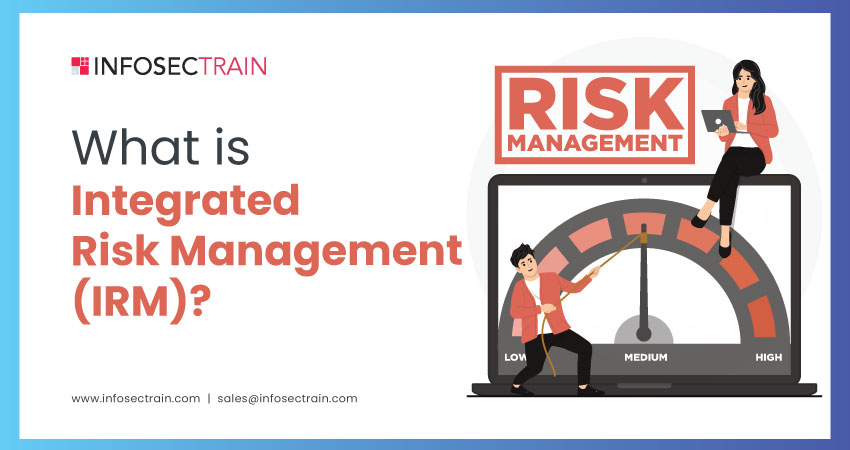What is Integrated Risk Management (IRM)?
“No matter the size, industry, or location, every business looks to achieve four IRM objectives — better performance, stronger resilience, greater assurance, and cost-effective compliance.”
In an era where businesses encounter various financial, operational, regulatory, and reputational threats, IRM (Integrated Risk Management) emerges as a strategic framework designed to consolidate and streamline risk-related activities across an organization. It embodies a fundamental shift from the traditional fragmented and reactive risk management practices to a proactive and integrated methodology that recognizes the interdependencies between different risk categories.

What is Integrated Risk Management?
Integrated Risk Management (IRM) is like a toolbox crafted with different tools and strategies that help us focus on cybersecurity and IT management risks. In the contemporary landscape of cybersecurity and regulatory compliance, the importance of risk management cannot be ignored, serving as the keystone for the success of agile and proficient system governance. An orientation secured in risk emphasizes its imperative role in enabling organizations to make informed and insightful decisions, utilizing heightened insights when safeguarding essential stakeholder data and critical enterprise infrastructures.
Different Aspects of Integrated Risk Management
IRM is a continuous process that involves the following key aspects:
- Strategy: IRM is aligned with the organization’s overall strategy and objectives. It helps the organization to identify and manage the risks that could impact its ability to achieve its goals.
- Assessment: IRM involves the identification, analysis, and evaluation of risks. This entails determining the potential risk sources, the possibility that each risk might occur, and the potential consequences of each risk for the organization.
- Response: IRM involves developing and implementing plans to mitigate the identified risks. This may include avoiding, reducing, transferring, or accepting the risk.
- Communication and Reporting: IRM involves communicating and reporting on risks to relevant stakeholders. This makes it easy to know that everyone in the organization understands the risks and how they can help manage them.
- Monitoring: IRM involves monitoring the effectiveness of risk management plans and making adjustments as needed. This includes monitoring changes in the organization’s environment and the subsequent emergence of new risks.
Importance of Integrated Risk Management
Integrated Risk Management, in its essence, equips organizations with a compass to navigate the network of risk-related questions that infiltrate their decision-making processes:
- Coordination of Risk Mitigation: Integrated Risk Management harmonizes the orchestra of decisions regarding risk mitigation, ensuring that these actions resonate in harmony rather than a discordance of distinct efforts.
- Anticipating Potential Outcomes: It empowers organizations to peer into the crystal ball of uncertainty, contemplating the potential consequences if risks remain unregulated, thereby enabling informed and proactive decision-making.
- Loss Avoidance and Success Amplification: At its core, Integrated Risk Management serves as a shield against potential losses while simultaneously acting as a catalyst for maximizing the prospects of success. It provides the tools to use risk as a foundation rather than an obstruction to success.
Best Practices for Integrated Risk Management
Here are some best practices to effectively implement an IRM framework:
- Holistic Approach: View risk management as a strategic initiative that aligns with the organization’s mission and goals. Start by promoting the importance of IRM from top leadership down to all levels of the organization.
- Risk Prioritization: Prioritize risks based on their impact and likelihood to help the organization focus on addressing the most critical issues, particularly in technological improvements.
- Automate Controls: Transition from manual to automated controls where feasible. Automation saves time, reduces costs, and enhances risk mitigation capabilities.
- Cultivate a Risk-aware Culture: Make risk management integral to your organization’s processes. Implement metrics and policies that address security and privacy risks involving all stakeholders.
- Align Business Goals, Cyber Strategy, and Compliance: Ensure that business objectives are closely tied to cybersecurity and compliance strategies. This alignment mitigates risks and drives decisions that promote secure and sustainable practices.
- Develop Effective Documentation and Reporting: Enable real reporting across all stakeholders as IRM spreads ownership throughout the organization. Effective documentation and reporting are essential for transparency and accountability.
- Consider the Right Technology: Implement technology solutions that support IRM at all levels, from ground-level stakeholders to the executive suite. This may include IRM software, content governance, and data management platforms to operationalize policies, security, and metrics.
ISO 31000 with InfosecTrain
InfosecTrain’s ISO 31000 Risk Manager training course is a comprehensive framework offering valuable guidance on risk management principles and establishing a robust risk management framework. This standard is instrumental in aiding organizations by furnishing essential directives for managing diverse risks associated with all facets of their business operations.




 1800-843-7890 (India)
1800-843-7890 (India) 
